 August 1, 2011
August 1, 2011
Spend Quality Time With MTs
By David Yeager
For The Record
Vol. 23 No. 14 P. 8
Patient safety is always the most critical issue in transcription. Doctors dictate patient reports, but how do they know the medical transcriptionist (MT) didn’t misinterpret a remark or incorrectly spelled the name of a drug? A minor typo could be a costly error. To help avoid disaster, quality assurance (QA) staff scour reports to make sure MTs don’t make mistakes.
Rita Bowen, MA, RHIA, CHPS, immediate past president of the AHIMA and HIM director at Erlanger Medical Center in Chattanooga, Tenn., understands the importance of quality transcription. When it comes to hiring transcription firms, she says low cost doesn’t always translate to good value.
“There is definitely a difference. I would always be looking at a company that has quality control measures built in,” she says. “If a [new transcriptionist] is having difficulty, they [need] someone [who can provide guidance]. That’s absolutely something that we look for all the time.”
Training Is Key
Carleen Thacker, director of operations at New England Medical Transcription, works with transcriptionists to not only correct mistakes but, more importantly, to prevent them in the first place. She recommends a documented auditing review process specific to each client. Such a process uses experienced MTs to teach colleagues about the specifics of each account. For instance, one hospital may want allergens typed in capital letters with a bolded “ALLERGY” heading added if none are dictated, while another may want the entire sentence about an allergen to be bolded. An effective QA program not only ensures that standard terminology is correct but also monitors these types of account specifics.
Each transcription firm has its own accuracy rate that must be maintained and policies for ensuring that all transcriptionists meet that standard. Thacker says an orientation program that familiarizes new MTs with technical procedures and account specifics provides a useful knowledge base. This type of counseling and support helps new hires reach target accuracy rates as quickly as possible.
After orientation, regular auditing helps track an MT’s progress. In the audits, errors are categorized and weighted based on type and severity. For example, a minor spelling error such as using “effect” instead of “affect” is less serious than mistaking the name of a medication. Immediate counseling for errors and rewards for meeting accuracy goals help maintain quality.
“We’ve found that this process works very well toward ensuring the highest standards for our MTs,” Thacker says. “The MTs really appreciate the monetary incentive for good scores on their quarterly audits.”
Avoiding serious errors also comes down to good dictation and training. According to HIM consultant Linnea Fraser, providers can improve the process by speaking clearly and taking a moment to spell out the names of difficult medications.
“Good quality helps facilities meet best practice industry standards for turnaround times,” she says. “If it’s a quality product, the processing of that document becomes much less time consuming.”
Training is equally valuable for institutions that have in-house MTs. Linda Ragazzo, medical transcription manager at Presbyterian Intercommunity Hospital, a 400-bed facility in Whittier, Calif., has seen many changes in transcription practices over the years. One of the most notable has been the growth of speech recognition technology. Ragazzo works with transcription platform vendor Nuance to improve her department’s efficiency. She says responsive customer service and the ability to track quality measures allow her to more effectively focus her energy on areas where MTs need the most help.
QA for Speech Recognition
With the advent of speech recognition, QA has begun to focus more on medical knowledge, such as drug names and symptoms. Kathy Martin, owner and developer of the online OAK Horizons Medical Transcription Curriculum, says speech recognition editors need to know enough about medicine to identify when the program has made a mistake. Similar words such as “hypertension” and “hypotension” can easily be mistaken by speech recognition software because there is frequently a disconnect between what the provider dictates and what the system “thinks” was dictated.
“People who are outside the field don’t understand that the brain has to be involved in what you’re doing,” Martin says. “[For people who are unfamiliar with medical terminology], if it’s spelled right, you may not notice that it’s the wrong word.”
An in-depth QA and mentoring process comes into play in that situation, says Thacker, adding that QA programs for speech recognition editors need to focus on context as well as terminology. With the nature of transcription shifting from a strictly grammar-based format to one that’s more content based, Ragazzo says MTs need help adapting.
“It takes a different kind of concentration because it’s so easy for your ears [to fool your eyes], but you have to be astute in catching the errors that the [speech recognition technology makes] because it isn’t 100%,” she notes.
A well-organized QA program can assist MTs in developing the mindset that speech recognition requires. Although speech recognition technology plays an increasingly prominent role in medical transcription, QA is just as important for traditional dictation practices. Whether in speech recognition or traditional dictation, the safety of patients comes down to QA.
“I used to look for cost. Now I look for quality,” says Fraser. “Having been in many different hospitals and health systems as a consultant, I have seen a lot of successful and not-so-successful stories in transcription. It all comes down to quality. That is the driving force.”
— David Yeager is a freelance writer and editor based in Royersford, Pa.



